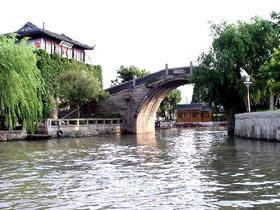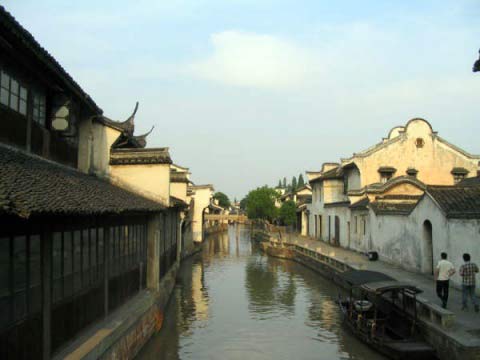
 With Taihu Lake in the south and the Yangtze River on its northern fringe, and semi-encircled by the Grand Canal, Suzhou has its unique scenery of crisscrossing waterways lined with houses and stone bridges in traditional style. Rich aquatic and farm produce has long made Suzhou "a land of rice and fish" and "the home of silk." It was called a "Paradise on Earth" in ancient times and is known as the "Venice of the East" today. Named "the city of gardens", Suzhou has always held a leading position in China's architectural art and landscape gardening. There were once over 200 gardens in the city, and 69 of them are still in good condition today. In December 1997, the UNESCO Heritage Committee added the Suzhou classical gardens to the World Heritage List.
With Taihu Lake in the south and the Yangtze River on its northern fringe, and semi-encircled by the Grand Canal, Suzhou has its unique scenery of crisscrossing waterways lined with houses and stone bridges in traditional style. Rich aquatic and farm produce has long made Suzhou "a land of rice and fish" and "the home of silk." It was called a "Paradise on Earth" in ancient times and is known as the "Venice of the East" today. Named "the city of gardens", Suzhou has always held a leading position in China's architectural art and landscape gardening. There were once over 200 gardens in the city, and 69 of them are still in good condition today. In December 1997, the UNESCO Heritage Committee added the Suzhou classical gardens to the World Heritage List.
Known as the nation's supplier of products for export, Suzhou has become a trade city, ranking only second to Shanghai among the major cities along the Yangtze Delta. Moreover, with many rich historical and cultural sites, as well as the natural scenery, Suzhou has become one of the most popular tourist cities in China.
Suzhou is located on the shores of Lake Taihu in the lower reaches of the Yangtze. The city covers a total area of 8,488 square km with 1,650 square km of urban area. It enjoys a mild, humid climate with an annual rainfall of 1,100 mm, an average annual temperature of 15.7C. Suzhou has a vast number of ponds and streams. The Grand Canal flows from north to south through the city, with rivers like Wangyu, Loujiang and Taipu connecting the east and west. Dotted in this chessboard are lakes like Yangcheng, Kuncheng and Dianshan. The scenery of hills and water in Suzhou is beautiful. Of the whole area, 10 per cent is cultivated fields, 30 per cent hills, and the rest covered with water. The average altitude of Suzhou is 4 meters.
Suzhou has a population of 5.83 million with 2.12 million in urban area. The main inhabitants are Han nationality which makes up 99 percent of the total population. The main religion is Buddhism and Taoism.

The history of Suzhou can be traced back to the Shang Dynasty (1,800 B.C.). During the Spring & Autumn Period in 514B.C, King He Lu of Wu State established Suzhou as the capital known as the "Great City of Helu" and since then the city's site and scale have remained virtually unchanged. It was the construction of the Jinghang Grand Canal in the Sui Dynasty (AD581-618) that marked the beginning of the prosperity of the city. The silk trade was established and reached its peak in the Southern Song Dynasty when the capital of China moved to Hangzhou. When the first Ming Emperor founded his capital in Nanjing, Suzhou continued to enjoy a privileged position within the orbit of the court, and to flourish as a center for the production and weaving of silk.

